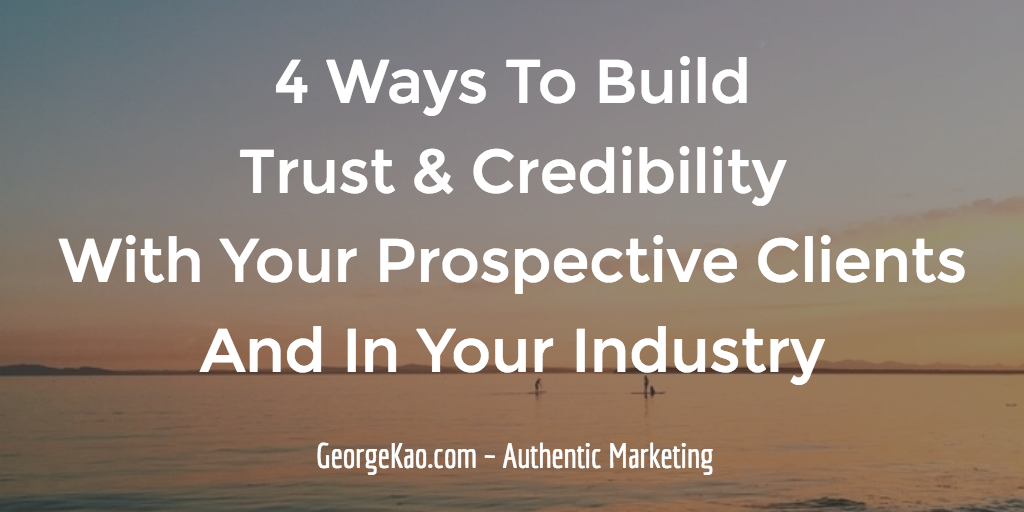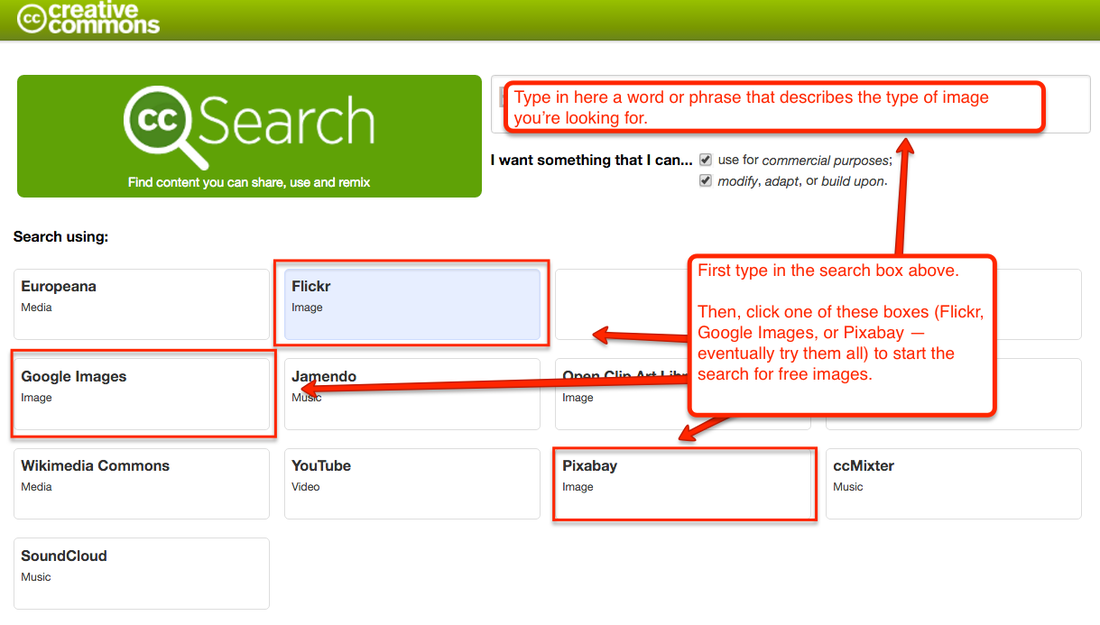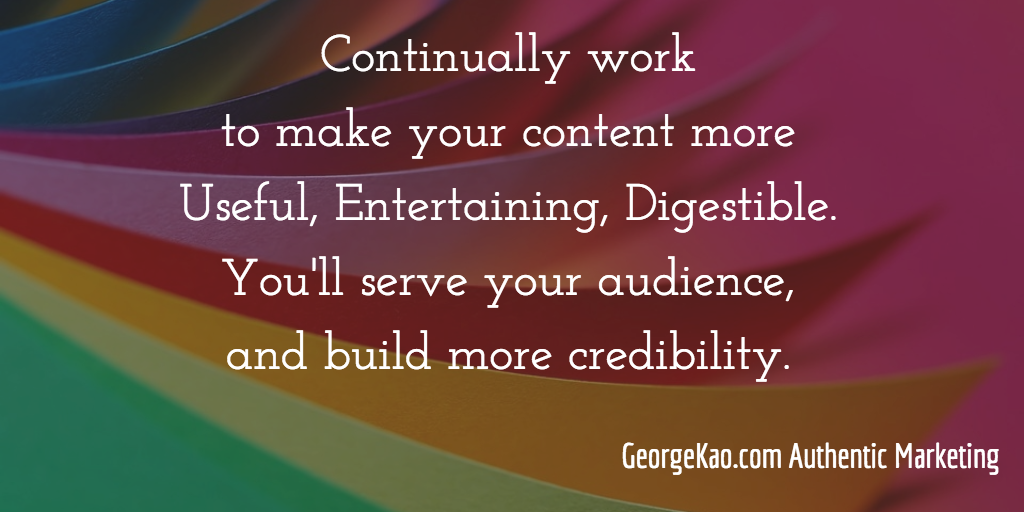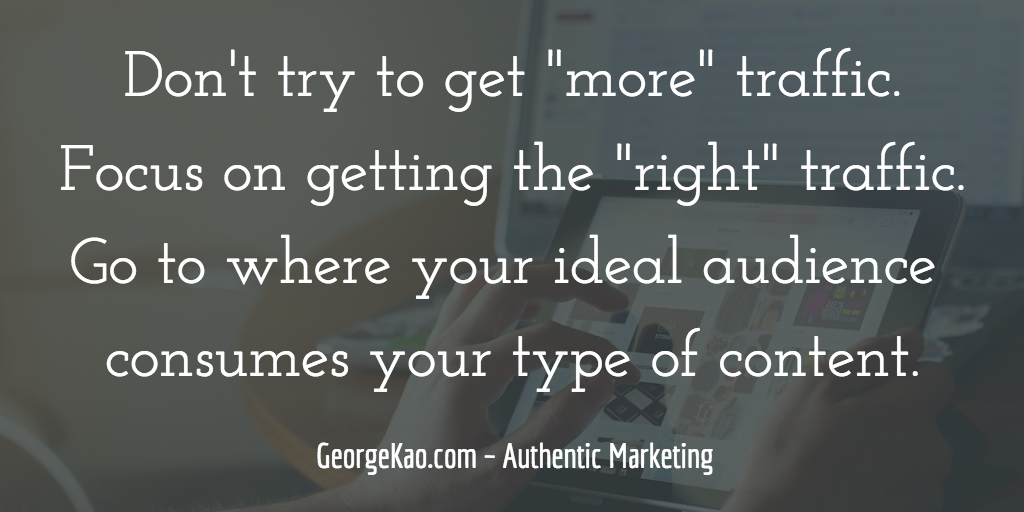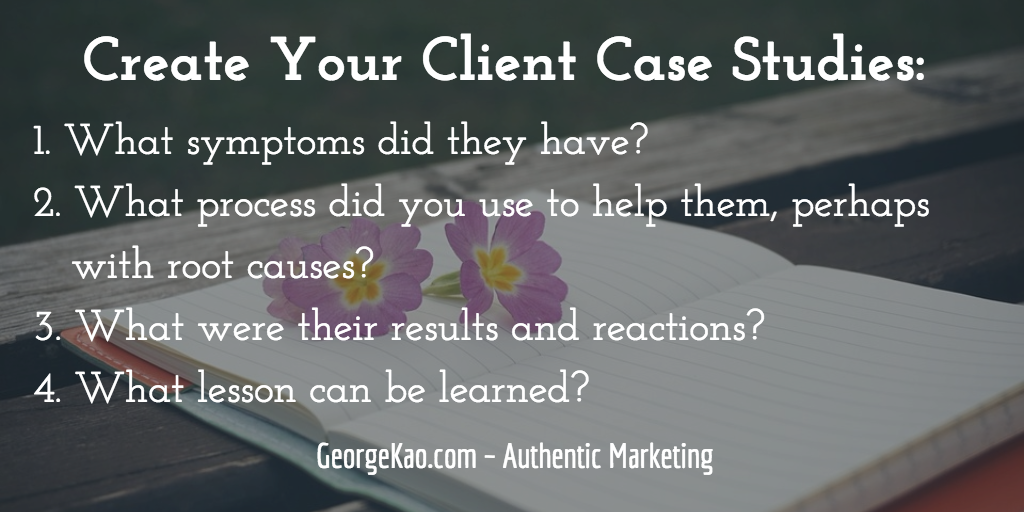How to Build Trust & Credibility with Your Prospective Clients and in Your Industry
"If only more people knew about my work..."
You believe that you have a valuable service to offer. Many people can truly benefit from your knowledge and experience.
You would now like to get through all marketplace noise and clutter. Of course, you could use marketing gimmicks and tricky headlines. But that’s not what your spirit of service is calling you towards...
A better way is to work on building your trust and credibility in the market.
In this article, I share 4 primary methods for doing so:
You would now like to get through all marketplace noise and clutter. Of course, you could use marketing gimmicks and tricky headlines. But that’s not what your spirit of service is calling you towards...
A better way is to work on building your trust and credibility in the market.
In this article, I share 4 primary methods for doing so:
- Content
- Case studies
- Contact
- Connection
Method 1 -- Content
"Content" is any message that is useful and/or entertaining to your ideal audience.
Here is how I view the main purpose of content. It is to serve the world with valuable knowledge, filtered through your own unique perspective, values, and style.
When you generously share content, you grow yourself in a multitude of ways:
Here is how I view the main purpose of content. It is to serve the world with valuable knowledge, filtered through your own unique perspective, values, and style.
When you generously share content, you grow yourself in a multitude of ways:
- Strengthening your authentic “voice”.
- Clarifying (to yourself, and to others) what your message really is.
- Drawing your ideal audience to you.
- And of course, your audience and the world is better as a result!
There are many ways to share content.
Ways to share include:
- Social media posts -- such as on Facebook and on LinkedIn
- Articles -- like the one you're reading, aka "blog posts"
- Videos -- of which I’ve created more than 250
- Podcast episodes -- you can see my favorites here
- Speaking in-person -- workshops, lectures, trainings, keynote speeches
- Webinars & teleclasses -- a webinar has visuals; a teleclass is just audio
- Infographics -- such as these
- eBooks -- published on Amazon Kindle is best; otherwise a downloadable PDF on your site
- Books -- printed books are still the best credibility builder; you can self-publish and have it available on Amazon through CreateSpace
- Audio Books -- if you have a book available on Amazon, you can easily turn it into an audiobook by using ACX
- Slideshows -- e.g. ones published on slideshare, example here
- Courses -- online courses can simply be several webinars, edited together; Udemy is the largest online course platform
How do you create great content?
Tip #1 -- Make your content useful.
Your content should be asuseful / helpful as possible to your ideal audience. Create your content from a spirit of “How can I truly serve my audience?”
To do this successfully, you need visualize and understand your ideal readers. Preferably, do this before you start creating your content.
For a moment, think about one of your favorite clients. See that person in your mind's eye, and feel connected to them in your heart.
Imagine them in a state where they truly appreciate everything you say. And whatever you would share with them is helpful to them... maybe even life-changing. (Remember, we are bringing to mind the "ideal reader!")
It is from this energetic space of full supportiveness that I invite you to create your content. This liberates you to be as creative as you can. Make your content from that mindset.
Then, after creating a draft, go back and edit your piece. Being in editing mode, you can imagine the major objections, questions, and concerns that your reader might have to your ideas.
Taking their objections one at a time, make your piece even more relevant, useful, and helpful to the ideal client you have in mind.
A powerful way to improve relevance is to include examples that illustrate your points.
I also recommend incorporating links to other blog posts or content (including yours) as a way for the reader to get deeper into the topic.
To do this successfully, you need visualize and understand your ideal readers. Preferably, do this before you start creating your content.
For a moment, think about one of your favorite clients. See that person in your mind's eye, and feel connected to them in your heart.
Imagine them in a state where they truly appreciate everything you say. And whatever you would share with them is helpful to them... maybe even life-changing. (Remember, we are bringing to mind the "ideal reader!")
It is from this energetic space of full supportiveness that I invite you to create your content. This liberates you to be as creative as you can. Make your content from that mindset.
Then, after creating a draft, go back and edit your piece. Being in editing mode, you can imagine the major objections, questions, and concerns that your reader might have to your ideas.
Taking their objections one at a time, make your piece even more relevant, useful, and helpful to the ideal client you have in mind.
A powerful way to improve relevance is to include examples that illustrate your points.
I also recommend incorporating links to other blog posts or content (including yours) as a way for the reader to get deeper into the topic.
Tip #2 -- Make your content more entertaining.
Next, edit your piece to make it moreentertaining. This, too, is an act of service to your audience. You are making the medicine go down easier for them.
A creative way of doing this is to include an interesting case study or story, especially of one of your clients. (You can always mention them anonymously or use a pseudonym, unless the client has given you permission to reveal their name.)
By doing this well, you help the audience to imagine themselves in your client's shoes. This makes your content more relevant to their life. And, you may even get a new client as a result.
Another way to make your content more entertaining/attractive is to include some images.
There are millions of free images you can use, check out Creative Commons Image Search. (Once there, use one of these options: Google Images, Pixabay, or Flickr.)
A creative way of doing this is to include an interesting case study or story, especially of one of your clients. (You can always mention them anonymously or use a pseudonym, unless the client has given you permission to reveal their name.)
By doing this well, you help the audience to imagine themselves in your client's shoes. This makes your content more relevant to their life. And, you may even get a new client as a result.
Another way to make your content more entertaining/attractive is to include some images.
There are millions of free images you can use, check out Creative Commons Image Search. (Once there, use one of these options: Google Images, Pixabay, or Flickr.)
You could also use Pablo, a free tool from Buffer, to easily create quote images, like this:
Tip #3 -- Make your content more digestible.
For articles / blog posts, it means making your paragraphs shorter, so it’s easier to read.
When it comes to the web, and how readers interact with the screen, one or two sentence paragraphs are very welcome.
And, short sentences increase impact.
A useful and free application to make your writing more digestible is The Hemingway Editor. I used it to make this article more readable.
For more tips on how to make your content more Useful, Entertaining, Digestible, check out this rich mindmap.
When it comes to the web, and how readers interact with the screen, one or two sentence paragraphs are very welcome.
And, short sentences increase impact.
A useful and free application to make your writing more digestible is The Hemingway Editor. I used it to make this article more readable.
For more tips on how to make your content more Useful, Entertaining, Digestible, check out this rich mindmap.
Creating Great Content Takes a Lot of Practice.
Through practice and observation of what is working for your audience, you better your skills at communication. And, you increase your mastery of your area of expertise.
In 2015, when I began making videos earnestly, I created over 200 videos. As you might imagine, not all 100 were good... maybe 10 were!
Have you read the story of the ceramics class? If not, check it out, and be inspired. It's a quick read.
In 2015, when I began making videos earnestly, I created over 200 videos. As you might imagine, not all 100 were good... maybe 10 were!
Have you read the story of the ceramics class? If not, check it out, and be inspired. It's a quick read.
"How do I get more traffic to my content?"
After creating your content, you are wondering how to get people to consume it?
If content is king, then distribution is queen.
Instead of focusing on “more traffic”, the key is actually in getting the right kind of traffic.
First, learn from some of your ideal clients where they get their information:
Which blogs do they read, if any?
Which newsletters are they subscribed to? (If you are on the phone with them, you can actually ask them to open their email inbox, and name a couple of newsletters they typically read.)
Which social media platforms do they most like to engage with?
Facebook? LinkedIn? Pinterest? Instagram? Twitter? Place your content on the platform(s) that your clients use. (Chances are they will pay more attention to either Facebook or LinkedIn.)
Which Facebook groups do they hang out in?
The largest social media platform, by far, is Facebook. It is very likely that you have many ideal clients who use Facebook frequently.
Join the Facebook groups that interest you, and where your ideal clients might be hanging out. Who up as a genuinely supportive person. Comment on threads where you can help or contribute your perspective.
Then reach out to the influencer(s) in that space, to be a resource about your expertise.
And remember: send out your best content in your own email newsletter! (Click that link for my email newsletters.)
If content is king, then distribution is queen.
Instead of focusing on “more traffic”, the key is actually in getting the right kind of traffic.
First, learn from some of your ideal clients where they get their information:
Which blogs do they read, if any?
Which newsletters are they subscribed to? (If you are on the phone with them, you can actually ask them to open their email inbox, and name a couple of newsletters they typically read.)
Which social media platforms do they most like to engage with?
Facebook? LinkedIn? Pinterest? Instagram? Twitter? Place your content on the platform(s) that your clients use. (Chances are they will pay more attention to either Facebook or LinkedIn.)
Which Facebook groups do they hang out in?
The largest social media platform, by far, is Facebook. It is very likely that you have many ideal clients who use Facebook frequently.
Join the Facebook groups that interest you, and where your ideal clients might be hanging out. Who up as a genuinely supportive person. Comment on threads where you can help or contribute your perspective.
Then reach out to the influencer(s) in that space, to be a resource about your expertise.
And remember: send out your best content in your own email newsletter! (Click that link for my email newsletters.)
Method 2 -- CASE STUDIES
An additional way to create trust and credibility is sharing more Case Studies.
Your prospective clients want to know that you can actually get the results that you're promising.
Or maybe you don’t promise “results” but you offer a supportive experience. That’s fine too, but your prospective clients want “proof” that working with you will feel valuable and enjoyable.
This is why it is important to include a few client testimonials on your website, and wherever else you are marketing your services.
Even more effective than testimonials, is to create and share more case studies. It has been mentioned in this article already but it bears repeating -- case studies help your marketing and perhaps more importantly, your own clarity about your strengths and best service.
Gathering your client case studies is a long-term effort, but an absolutely worthwhile one. It sharpens your awareness about “what is it that I do for clients, that works best for them?”
Your prospective clients want to know that you can actually get the results that you're promising.
Or maybe you don’t promise “results” but you offer a supportive experience. That’s fine too, but your prospective clients want “proof” that working with you will feel valuable and enjoyable.
This is why it is important to include a few client testimonials on your website, and wherever else you are marketing your services.
Even more effective than testimonials, is to create and share more case studies. It has been mentioned in this article already but it bears repeating -- case studies help your marketing and perhaps more importantly, your own clarity about your strengths and best service.
Gathering your client case studies is a long-term effort, but an absolutely worthwhile one. It sharpens your awareness about “what is it that I do for clients, that works best for them?”
Simple structure to create case studies:
1.Start with describingthe problem or yearning that your client had, before they started working with you. What symptoms did they experience that motivated them to seek a solution to their problem? (Keep your client name anonymous, unless you ask and get their explicit permission.) What specific questions, challenges, or concerns did they have?
2. Briefly describe how you worked with your client. What process did you use? What modality did you employ? What tools, exercises, even your way of being?
3. Describe the client's results after working with you. What problems were solved? What goals did they achieve? What hopes were realized? What unexpected benefits did they see in their life?
Or, if you aren’t promising “results” but rather, an “experience”, then what did the client expect, that they did experience? What were some unexpected feelings or moments that they enjoyed?
4. What was the lesson(s) learned, or some "aha moment" from the client, that could benefit your audience? This element separates your case study from a sales pitch – it makes your article useful to read. Include several lessons or tips if you can.
Just like with content creation, you need to get into the“case study” mindset today, so you can begin creating case studies. Remember: this willimprove your services, as well as makeyour marketing more credible.
2. Briefly describe how you worked with your client. What process did you use? What modality did you employ? What tools, exercises, even your way of being?
3. Describe the client's results after working with you. What problems were solved? What goals did they achieve? What hopes were realized? What unexpected benefits did they see in their life?
Or, if you aren’t promising “results” but rather, an “experience”, then what did the client expect, that they did experience? What were some unexpected feelings or moments that they enjoyed?
4. What was the lesson(s) learned, or some "aha moment" from the client, that could benefit your audience? This element separates your case study from a sales pitch – it makes your article useful to read. Include several lessons or tips if you can.
Just like with content creation, you need to get into the“case study” mindset today, so you can begin creating case studies. Remember: this willimprove your services, as well as makeyour marketing more credible.
Method 3 -- CONTACT
A third way of building trust and credibility is to give people the actual experience of working with you.
There are several ways to do this.
You Could Offer Free Sample Sessions.
These are no-charge, 1-1 sessions that you give to people who haven’t ever experienced working with you.
Decide whether your sessions would be 30, 45, or 60 minutes (start with 30 and see if that is a good enough experience for the prospective client.)
One client of mine planned to offer 20 free calls to take place in the course of 2 weeks. A few weeks before the campaign, she rallied her warm contacts to support her in spreading the word.
In some cases, her own contacts were actually ideal clients for her, so they also took her up on the free call. As a result, she got several new clients from this effort. Imagine doing the same thing with your colleagues.
Another client of mine does such deep and broad transformational work with her clients, that it's sometimes difficult for her to explain what she does.
She posted an offer/request on Facebook -- gifting 3 real sessions with her (60 minutes to each person) to those who are yet to experience her incredible work. In exchange, she asked the participants to describe what she does, in their words.
(She had been posting content regularly on her Facebook for awhile, and thus had already built some trust with her audience.)
3 readers accepted her gift session, and 2 of those became new clients!
She is, of course, now regularly repeating that strategy.
You Could Offer Free Group Calls.
If it makes sense for your service, consider offering occasional free group calls (using Zoom video conference, for example).
This gives your audience an experience of working with you, while being able to just listen into the call if they wish to.
When Was The Last Time You Did Some In-Person Speaking?
Hands down, the most powerful way to make contact with prospective clients is when you are a speaker at an in-person event. Besides having a well-written book, there is perhaps no better credibility-building activity.
To get started, or to get back into this important activity, make a list of topics that you would love to speak on. Write the titles as if they could be on the agenda at a conference or event where your ideal audience would attend.
Next, take a look at some list of people you already know -- your “warm contacts”. Here are ways of doing this:
Once you have a list of your warm contacts (people who know you), consider contacting three types of people:
Doing in-person speaking is a powerful way to establish your credibility. Try to video record (or at least audio record) those events, and have someone take a few pictures of you speaking in front of such audiences.
There are several ways to do this.
You Could Offer Free Sample Sessions.
These are no-charge, 1-1 sessions that you give to people who haven’t ever experienced working with you.
Decide whether your sessions would be 30, 45, or 60 minutes (start with 30 and see if that is a good enough experience for the prospective client.)
One client of mine planned to offer 20 free calls to take place in the course of 2 weeks. A few weeks before the campaign, she rallied her warm contacts to support her in spreading the word.
In some cases, her own contacts were actually ideal clients for her, so they also took her up on the free call. As a result, she got several new clients from this effort. Imagine doing the same thing with your colleagues.
Another client of mine does such deep and broad transformational work with her clients, that it's sometimes difficult for her to explain what she does.
She posted an offer/request on Facebook -- gifting 3 real sessions with her (60 minutes to each person) to those who are yet to experience her incredible work. In exchange, she asked the participants to describe what she does, in their words.
(She had been posting content regularly on her Facebook for awhile, and thus had already built some trust with her audience.)
3 readers accepted her gift session, and 2 of those became new clients!
She is, of course, now regularly repeating that strategy.
You Could Offer Free Group Calls.
If it makes sense for your service, consider offering occasional free group calls (using Zoom video conference, for example).
This gives your audience an experience of working with you, while being able to just listen into the call if they wish to.
When Was The Last Time You Did Some In-Person Speaking?
Hands down, the most powerful way to make contact with prospective clients is when you are a speaker at an in-person event. Besides having a well-written book, there is perhaps no better credibility-building activity.
To get started, or to get back into this important activity, make a list of topics that you would love to speak on. Write the titles as if they could be on the agenda at a conference or event where your ideal audience would attend.
Next, take a look at some list of people you already know -- your “warm contacts”. Here are ways of doing this:
- Look at your email inbox and go to the “sent” folder -- so you can easily find the people you’ve recently communciated with.
- Go to your list of LinkedIn connections.
- Go to your Facebook profile and click on the “Friends” tab.
- Look at your phone’s contacts app.
Once you have a list of your warm contacts (people who know you), consider contacting three types of people:
- Those who might be hosts of in-person group meetings such as conferences, organizational events, local meetups. Contact them to have a conversation about whether you might speak at their event or to help you brainstorm ideas of which events you could speak at.
- Those in your field (or a related field) who might have spoken at in-person events. Contact them to learn how they got invited, or approved, to speak at those events.
- Those who are well-connected in your field, and who are friendly towards you. Contact them for a conversation to help you brainstorm how you might break into the speaking circuit.
Doing in-person speaking is a powerful way to establish your credibility. Try to video record (or at least audio record) those events, and have someone take a few pictures of you speaking in front of such audiences.
Method 4 -- CONNECTIONS
If you have a mutual friend, colleague, or client who likes your work, ask if they might be willing to introduce you to a prospective client,or to someone who might open up doors for you.
LinkedIn can be very useful for this kind of thing. Go to the LinkedIn profile of the friend/client/colleague who likes your work. Then, scroll down on their profile until you find the "Connections" section ... it's toward the bottom of someone's LinkedIn profile, just above the section called "Groups".
In the Connections section, there's a magnifying glass at the upper right. Here, you can search for a profession or interest that describes your ideal client…
LinkedIn can be very useful for this kind of thing. Go to the LinkedIn profile of the friend/client/colleague who likes your work. Then, scroll down on their profile until you find the "Connections" section ... it's toward the bottom of someone's LinkedIn profile, just above the section called "Groups".
In the Connections section, there's a magnifying glass at the upper right. Here, you can search for a profession or interest that describes your ideal client…
...then ask your mutual contact to connect you with that person.
Here's one way to ask your mutual contact:
"I saw that [NAME] is connected to you on LinkedIn. Do you know them well enough to know whether they could be looking for services like mine? If so, would you feel comfortable introducing us? If I can truly serve them, it'll be great for us to know each other."
Remember to ask in a humble, but confident way. It is a fair request, but don't be entitled that they should introduce you.
Know that if the 3rd party turns out to be an ideal client, everyone wins:
- You get a new client,
- The client gets a service provider they really appreciate,
- and the connecting person can feel great that they helped form a new friendship with a fairly simple action!
So there you have it... 4 effective methods to build trust and credibility with your ideal audience.
Which of the 4 methods above do you think will work for you?
What questions do you have about applying this advice?
Comment below. It’s always a pleasure to hear from you.
Whichever method you find will work best for you, use it consistently. And you'll find that your marketing becomes easier and easier over time.
Interesting side benefit: These methods also help you build trust in yourself and your expertise. Certainly, the added self-trust will bring clarity and confidence to all of your marketing and services.
To comment on this post in Facebook click here.
To comment in LinkedIn click here.
What questions do you have about applying this advice?
Comment below. It’s always a pleasure to hear from you.
Whichever method you find will work best for you, use it consistently. And you'll find that your marketing becomes easier and easier over time.
Interesting side benefit: These methods also help you build trust in yourself and your expertise. Certainly, the added self-trust will bring clarity and confidence to all of your marketing and services.
To comment on this post in Facebook click here.
To comment in LinkedIn click here.
George Kao is a business coach who focuses on ethical marketing, and coaches his clients to create an online presence they can be proud of. In the past 3 years George has conducted over 1,000 1-1 business coaching sessions with clients. For many wisdom-based solopreneurs, George Kao is the go-to expert and advisor on the topics of heart-based marketing, and how to create a business that is truly fulfilling. If you’d like George’s support in applying the ideas in this article, check out his business coaching services.
